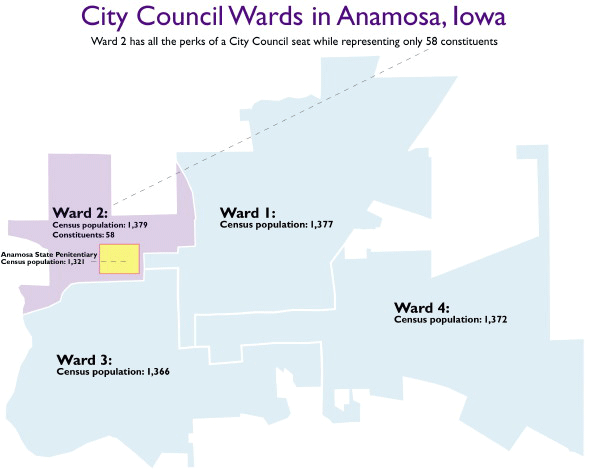The Problem
 The way the Census Bureau counts people in prison creates significant problems for the fairness of our nation’s democracy. When the Census Bureau counts incarcerated people in prison instead of at home, there is a dramatic distortion of representation at local and state levels, and an inaccurate picture of community populations for research and planning purposes.
The way the Census Bureau counts people in prison creates significant problems for the fairness of our nation’s democracy. When the Census Bureau counts incarcerated people in prison instead of at home, there is a dramatic distortion of representation at local and state levels, and an inaccurate picture of community populations for research and planning purposes.
Every ten years, when the Census Bureau endeavors to count every person residing in the country, they make a mistake: they count incarcerated people as residents of the towns where they are confined, even though they are barred from voting in 48 states and almost always return to their homes after being released. The practice not only skews the population count, but also defies most state constitutions and statutes, which explicitly state that incarceration does not change a residence.
The Bureau’s approach to counting incarcerated people dates back to the beginning of the census, when it was important only to count the number of people in each state to ensure equal representation in Congress. Congressional apportionment relied on the comparative populations of the states, not where people were relative to each other within each state. Now that Census data are used for redistricting at all levels of government, the specific location of populations is critical. The prison population has exploded in the past couple of decades; counting the people in prison in the wrong place now undermines the Supreme Court’s requirement that political power be apportioned on the basis of population. The process of drawing fair and equal districts fails when the underlying data are flawed.
State democracy
“This bogus inflation gives prison districts undeserved strength in the state legislature and more influence than they would otherwise have in state affairs.”
Phantom Constituents in the Census, New York Times editorial, Sept. 26, 2005
Some state legislative districts draw large portions of their political clout, not from actual residents, but from the presence of a large prison in the district. Because of the artificially bolstered population count from incarcerated people, the districts with large prisons send representatives to the state capitol who have less constituents than the representatives from districts without prisons. These representatives advocate for the interests of free people in their district, giving those in the district of the prison far more political clout than their neighbors in the districts next door.
Because prisons are disproportionately built in rural areas but most incarcerated people call urban areas home, counting prisoners in the wrong place results in a systematic transfer of population and political clout from urban to rural areas. For example:
- 40% of people incarcerated in Maryland prisons are from Baltimore, yet 90% of them are counted outside the city.
When this data is used to draw legislative districts, the impact is startling. Many districts that contain prisons have a significant percentage of their "residents" behind bars:
- After the 2010 redistricting, there were 24 state house districts across the country where prisons accounted for 10% or more of the districts' population.
Using prisons to enhance votes in individual districts within one region cumulatively gives the whole region additional representation. For example:
- Before New York ended prison gerrymandering in 2010, the unadjusted Census data used in redistricting added an extra district in the upstate region, giving the constituents there more political representation than their counterparts in other areas. Without using prison populations as padding, seven state senate districts would have had to be redrawn, causing line changes throughout the state.
When districts with prisons receive enhanced representation, every other district in the state without a prison sees its votes diluted. And this vote dilution is even larger in the districts with the highest incarceration rates. Thus, the communities that bear the most direct costs of policing and incarceration are the communities that are the biggest victims of prison gerrymandering.
The Census Bureau’s decision to count incarcerated people in the wrong place interferes with equal representation in virtually every state. Our research on how prison gerrymandering distorts democracy in the states is collected on our state impact page.
Local democracy
The relatively small populations of cities and towns mean that the placement of a single prison can have a significant impact on their population. Rural residents who live in the same town or city as a prison, but not in its district, have their voting power severely diluted.
In many rural county and city governments, substantial portions of individual districts consist of incarcerated people, not actual residents. In a number of places, we've found elected officials who owe a majority of their clout to prison populations.

One of those places was the small city of Anamosa Iowa, which became a national symbol of prison gerrymandering when a city council incumbent retired, no one ran for office and Danny R. Young was elected with two write-in votes. A large state penitentiary means that Ward 2 had just a handful of city residents, compared to about 1,400 in each of the other 3 wards. The actual population (without the padding of the incarcerated population) of Councilman Young's district was 58, giving his constituents about 25 times as much clout as those in the other wards.
The residents of Anamosa rejected this inequality and changed their form of government to eliminate the prison district. While Anamosa chose to eliminate the district system altogether, other places have simply removed prisons from the local population count when drawing their district lines.
To date, over 200 communities have discovered the problem with their representation and successfully drew districts that exclude the prison populations. Our local impact page has analyses of democratic distortion on the local level, and examples of communities that have lobbied for fair representation.
Racial Impact
Like most aspects of mass incarceration and the prison industrial complex, prison gerrymandering has a significant racial impact against Black and Brown communities. Because Black and Brown people are disproportionately arrested and sentenced to prison, mass incarceration leads to the geographic transfer of significant populations of people out of urban communities of color to rural prison districts.
Once there, the Census Bureau counts incarcerated people - who are disproportionately urban, Black, and Latino - as if they were willing residents of the disproportionately white and rural locations that host prisons. The miscount artificially inflates the population and therefore political representation of the predominantly white and rural districts that contain prisons, and the urban communities of color that most incarcerated people call home lose political power.
Prison gerrymandering may have arisen by accident, but the reluctance of state and federal governments to eliminate it is rooted in the systematic disenfranchisement of Black and Brown communities. Ending prison gerrymandering would ensure that urban communities of color have their full population count when political representation is allocated for future districts.
Events
- April 15-17, 2025:
Sarah Staudt, our Director of Policy and Advocacy, will be attending the MacArthur Safety and Justice Challenge Network Meeting from April 15-17 in Chicago. Drop her a line if you’d like to meet up!
Not near you?
Invite us to your city, college or organization.



